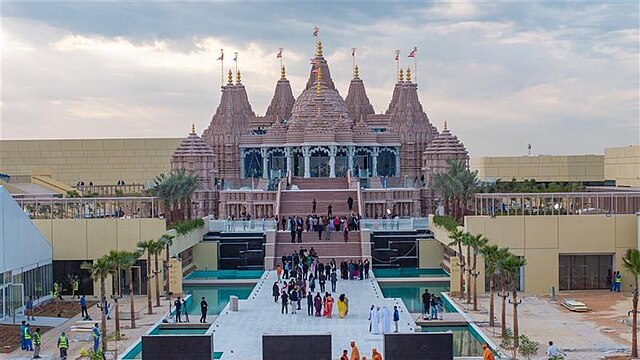The Pran-Pratishtha of the sprawling Hindu temple in Abu Dhabi built by the Bochasnawasi Akshar Purushottam Swaminarayan Sanstha or the BAPS society began on February 14, 2024, ahead of its inauguration by PM Narendra Modi. Built on 27 acres of land, this will be the first stone Hindu temple in Abu Dhabi which features a unique blend of Indian culture and the UAE identity.
The focal point of his brief two days visit to the Gulf Nations is the inauguration of the BAPS Mandir which is the second big Hindu temple to be inaugurated in the United Arab Emirates (UAE). In October 2022, Dubai temple was inaugurated by UAE Minister of Technology His Highness Shiekh Nahyan bin Mubarak Al Nahyan. Prime Minister Narendra Modi will also lead a dedicated ceremony of the temple which will be opened to the public on March 1, 2024.
The temple is built on a 27-acre plot of land donated by the UAE government in Abu Mureikhah, near Al Rahba off the Dubai-Abu Dhabi Sheikh Zayed Highway. the stone laying ceremony took place in 2019. The sprawling structure has a prayer hall with the capacity to hold 3000 people, a community centre, an exhibition hall, library and a children park. The temple façade features elegant marble carvings set against a pink sandstone backdrop created from more than 25,000 pieces of stone by skilled artisans from Rajasthan and Gujarat.
The temple features traditional Nagar architecture style It stands 108 feet tall and is crowned by with seven shikars (Spires) each representing one of the seven Emirates of the UAE. The BAPS Mandir is surrounded by meticulously crafted ghats and features of Ganga and Yamuna Rivers. The temple has two central domes namely the Dome of Harmony and the Dome of Peace.
The entrance of the temple is marked by eight idols, which symbolizes eight values foundational to the Sanatana Dharma. Additionally, the temple space also featured stories from ancient civilisations such as Maya, Aztec, Egyptian Arabic, European, Chinese and African all captured in stone. Tales of Ramayana can also be found on the structure.
The temple houses seven shrines, each dedicated to different deities hailing from North, East, West and South parts of India. To reduce carbon footprint, the temple’s construction has incorporated fly ash to replace a significant portion of cement in the concrete mix. Around 150 sensors monitor the temple structure, pressure, stress, and seismic events, ensuring the safety and longevity of the temple.
The BAPS Mandir has already won seven accolades, including the Best Mechanical Project of the Year 2019, at the MEP Middle East Awards, Best Interior Design Concept of the Year 2020, Best Architectural Style and Best Traditional Nagar Style.


















Comments